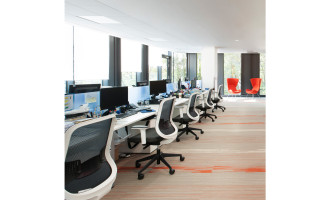Hot desking is here to stay, with flexible working quickly becoming the new normal. For many businesses, it’s a great way to use space efficiently and encourage collaboration. But while hot desking sounds simple in theory, the practical side can be tricky, especially when it comes to keeping everyone comfortable, healthy, and productive.
At Posture People, we’ve helped thousands of organisations, from small teams to national companies, create ergonomic hot desking setups that work for everyone. Here’s our practical guide to making your shared workstations both flexible and supportive.
Why Ergonomics Matter in a Hot Desking Environment
When a single workstation might be used by ten different people in a week, ergonomics becomes essential. Everyone has their own posture, height, and physical needs. Without proper adjustments, shared setups can quickly lead to discomfort, poor productivity, or even time off work.
Our golden rule? A good hot desk should be just as adaptable as the people using it. That means easy adjustments, reliable equipment, and simple tools that support posture, no matter who sits down.
Key Ingredients for Hot Desking Success
- Adjustability: Chairs, desks, and monitors should all be quick and easy to adapt.
- Speed: If setup takes more than a few minutes, employees won’t take the time to make needed adjustments.
- Personal comfort: Keep cushions, wrist rests, and lumbar supports on hand for anyone who needs them.
- Education: Even the best kit needs a bit of guidance; make sure people know how to adjust workstations properly.
Step-by-Step: Designing a Comfortable Hot Desk
1. Start with a Fully Adjustable Chair
Fixed office chairs rarely suit everyone. Choose robust, ergonomic seating with simple, intuitive levers for seat height, lumbar depth, and armrest adjustment. A breathable mesh back also helps keep employees comfortable throughout the day.
Our picks:
- Toleo Ergonomic Mesh Office Chair – Ideal for shared environments, with adjustable lumbar support and arms.
- Kickster Ergonomic Chair – Offers a perfect balance of style, quality, and affordability.
- VELA Tango 300 Bariatric Work Chair – Excellent for heavier users, offering great support and stability.
2. Use Sit-Stand or Height-Adjustable Desks
Hot desking layouts need to cater to a range of body types and preferences. Sit-stand desks allow users to vary their posture throughout the day while maintaining their work duties. Electric or manual options with memory settings make it even easier for each user to find their ideal setup in seconds.
3. Make Monitor Adjustments Simple
Screens should sit at eye height to prevent neck and shoulder strain. Fixed stands rarely suit everyone, so adjustable monitor arms or risers are a must.
Our picks:
- Fellowes Classic TFT Rotating Monitor Riser – Adjustable height and full rotation make this a versatile choice for shared setups.
4. Choose the Right Keyboard and Mouse
Hot desking works best with compact, wireless accessories that can be quickly paired with any computer. Add wrist and mouse supports to help reduce strain and support neutral hand positioning.
Our picks:
- Kensington Dual Wireless Compact Keyboard – Switch easily between devices.
- Kensington Foam Keyboard Wrist Rest and Foam Mousepad with Wrist Rest – Great for reducing wrist pressure.
5. Make Laptops Work for You
Laptops are convenient, but not great for posture when used flat on a desk. Each hot desk should include a laptop stand so users can raise screens to eye level and work more comfortably.
Our picks:
- Leitz Ergo Adjustable Multi-Angle Laptop Stand – Works with almost any device and adjusts in seconds.
- Fellowes Breyta Laptop Riser – A sturdy, stable option ideal for shared spaces.
6. Add Optional Back and Seat Supports
No two users are alike. Keep lumbar cushions, mesh backs, and seat pads available so people can fine-tune their comfort and avoid fatigue, which is especially important in shared setups.
Our picks:
- Fellowes Office Suites Mesh Back Support – Great for all-day spinal comfort.
7. Don’t Forget Footrest
Footrests can make a big difference for shorter users and anyone needing extra stability. They also encourage better circulation and posture at sit-stand desks.
For Facilities Managers: Keeping Hot Desking Ergonomic
- Standardise your setup: Make sure every workstation includes the same ergonomic essentials. An adjustable chair, monitor/ laptop riser, wireless keyboard, wireless mouse, and extra supports.
- Educate staff: Add quick setup guides on desks or share short videos so people can adjust their workstations correctly.
- Regular assessments: Schedule DSE (Display Screen Equipment) reviews to catch any issues early. Our Online DSE Self-Assessment makes this easy to roll out across teams.
- Keep spares handy: A small stock of cushions, wrist supports, and cable tidies helps staff customise their desks in seconds.
- Be inclusive: Include at least one specialist chair (e.g. bariatric or task-specific) per area so every employee has what they need to work comfortably.
Quick Checklist: What Every Hot Desk Needs
- Adjustable ergonomic chair
- Height-adjustable or sit-stand desk
- Monitor arm or riser
- Compact wireless keyboard and mouse
- Wrist and mouse rests
- Laptop stand
- Lumbar and seat supports
- Footrest
Making Hot Desking Work for Everyone
Hot desking doesn’t have to mean compromise. With the right ergonomic setup, clear guidance, and a few simple accessories, your shared workspace can be both flexible and healthy.
At Posture People, we specialise in creating ergonomic environments that support wellbeing and productivity—whatever your working setup.
Want to make your flexible workspace work better for your team?
Explore our range of ergonomic furniture and accessories, or get in touch for tailored advice on setting up your hot desking area.
Contact us today by calling 0330 332 0880 or alternatively dropping us an email at enquiries@posturepeople.co.uk to see how we can help.




